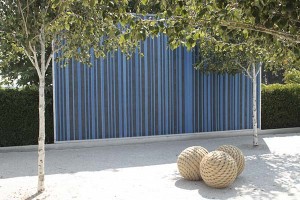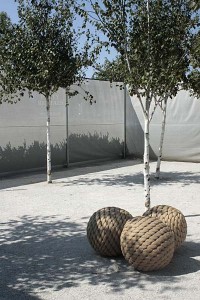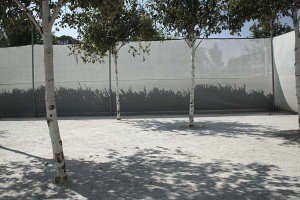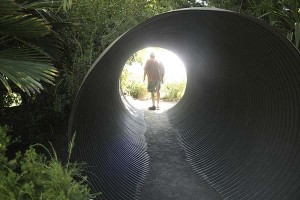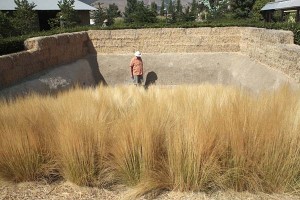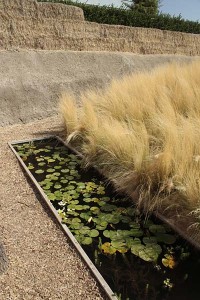These are the last of the photos I took at the gardens at CornerStone Sonoma. Looking through this second batch it seems that the gardens below rely heavily on hardscape details and less on plants. None of them are gardens without plants, but the green stuff definitely plays second fiddle to the more engineered parts of the gardens.
Yoji Sasaki’s The Garden of Visceral Serenity features this terrific walkway: a central, solid strip that alternates with horizontal stripes of varying widths.
Topher Delaney has this striking installation made up of a very short menu of elements: a blue-and-dark-gray striped wall, birches, three balls made of rope, white shade cloth surrounding the space, a bordering hedge and white crushed stone beneath your feet.
The color palette is reduced down to white, gray, black, green and the insistent blue of the backdrop and–today, anyway–the sky.
Most people plant birches because the trees have striking white trunks. But with the ground and walls being white, the birch trunks almost disappear, leaving a sense of green sheltering foliage floating overhead.
At mid-morning, the shadows of the trees draw striking forms underfoot, and shadows of the plantings next door make soft patterns on the white shade screen.
I liked this detail at Walter Hood’s Eucalyptus Memory garden. Garden designers often use single chairs or long benches to suggest a point of repose in the landscape. Here, Hood has used two chairs next to each other in the foreground and three in the distance, next to a pond, instead of the more expected bench. I wonder, is the fact that you have a chair to yourself meant to reinforce your sense of interior contemplation, even when there’s someone sitting next to you?
The rest of Hood’s installation consists of very few materials. Most dominant are two tall mesh panels that frame a view to a distant pond. One side is empty, the other contains eucalyptus branches and leaves. After a few moments of looking at the garden, what hits you next–and hits you hard–is the smell of the drying eucalyptus in the one panel. This is a garden for more senses than just sight.
Another sense, that of sound, is reinforced in David McCrory’s and Roger Raiche’s Rise garden. A steel tube runs through it, the kind that you see used for drainage under a road. As you walk through it you feel a sense of shelter, and the sounds of the surrounding world change as they echo gently through the chamber.
Pamela Burton designed the last of the spaces that I wanted to share. Her Earth Walk burrows into the land, and requires that you descend into the garden to fully experience it.
The earthen color of the hay bales and the adobe mud walls reminded me of the desert.
Once you pass a big, solid of Mexican feather grass and approach the bottom, you’re surprised with a long rectangular pond with waterlilies and fish. It felt like an oasis.
By the time you drop the eight feet or so into the bottom of this installation you can’t see any of the gardens around it. What you experience is reduced down to the walls, the grasses, the sky above, and the water below.
My final reactions to visiting Cornerstone were similar to going to a little museum and seeing a collection of single works by a number of artists. There’s a little bit of tension, a bit of competition going on between the pieces. Some landscape architecture can work well this way, where the designer makes a statement and you can appreciate what’s being said. You then move on to the next piece and try to figure out what’s going on with it. But if you want a landscape architecture that’s deeply rooted in the surroundings and its history, you might leave here wanting more than many of the works deliver.
In the end, one thing Cornerstone did very well for me that a lot of other landscape architecture doesn’t comes from the intimate scale of most of its gardens. These are gardens the size of many residential lots. These are spaces that tell you that interesting landscape design doesn’t have to be scaled to massive public works or some gonzo pallazzo.
For more looks at Cornerstone Sonoma, check out Alice Joyce’s postings on her blog, Bay Area Tendrils Garden Travel.


